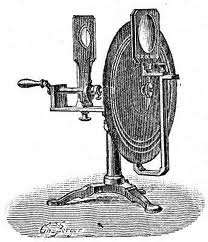1831: Joseph Henry and Michael Faraday’s work with electromagnetism makes possible the era of electronic communication to begin.
1876: George Carey wanted to do a complete television system and in 1877 he made drawings for what he called a "selenium camera" that would allow people to "see by electricity."
1880: The inventors Bell and Edison conceive on telephone devices that transmit image and sound. Bell's photophone used light to transmit sound and he wanted to advance his device to also send images.
Soon after 1900, the momentum shifted from ideas and discussions to physical development of television systems. Two major paths in the development of a television system were pursued by inventors.
Inventors attempted to build echanical television systems based on Paul Nipkow's rotating disks
Vladimir Zworkin demonstrates the first practical electronic system for both the transmission and reception of images using his new kinescope tube.
John Baird opens the first TV studio, however, the image quality was poor.
1930
Charles Jenkins broadcasts the first TV commercial.
The BBC begins regular TV transmissions.
1933
Iowa State University (W9XK) starts broadcasting twice weekly television programs in cooperation with radio station WSUI.
1936
About 200 hundred television sets are in use world-wide.
The introduction of coaxial cable, which is a pure copper or copper-coated wire surrounded by insulation and an aluminum covering. These cables were and are used to transmit television, telephone, and data signals.
The first experimental coaxial cable lines were laid by AT&T between New York and Philadelphia in 1936. The first regular installation connected Minneapolis and Stevens Point, WI in 1941.
The original L1 coaxial-cable system could carry 480 telephone conversations or one television program. By the 1970's, L5 systems could carry 132,000 calls or more than 200 television programs.
1937
CBS begins its TV development.
The BBC begins high definition broadcasts in London.
Brothers and Stanford researchers Russell and Sigurd Varian introduce the Klystron. A Klystron is a high-frequency amplifier for generating microwaves. It is considered the technology that makes UHF-TV possible because it gives the ability to generate the high power required in this spectrum.
1939
Vladimir Zworkin and RCA conduct experimentally broadcasts from the Empire State Building.
Television was demonstrated at the New York World's Fair and the San Francisco Golden Gate International Exposition.
RCA's David Sarnoff used his company's exhibit at the 1939 World's Fair as a showcase for the 1st Presidential speech (Roosevelt) on television and to introduce RCA's new line of television receivers, some of which had to be coupled with a radio if you wanted to hear sound.
The Dumont company starts making tv sets.
1940
Peter Goldmark invents a 343 lines of resolution color television system.
1941
The FCC releases the NTSC standard for black and white TV.
1943
Vladimir Zworkin developed a better camera tube called the Orthicon. The Orthicon (see photo right) had enough light sensitivity to record outdoor events at night.
1946
Peter Goldmark, working for CBS, demonstrated his color television system to the FCC. His system produced color pictures by having a red-blue-green wheel spin in front of a cathode ray tube.
This mechanical means of producing a color picture was used in 1949 to broadcast medical procedures from Pennsylvania and Atlantic City hospitals. In Atlantic City, viewers could come to the convention center to see broadcasts of operations. Reports from the time noted that the realism of seeing surgery in color caused more than a few viewers to faint.
Although Goldmark's mechanical system was eventually replaced by an electronic system he is recognized as the first to introduce a broadcasting color television system.
1948
Cable television is introduced in Pennsylvania as a means of bringing television to rural areas.
A patent was granted to Louis W. Parker for a low-cost television receiver.
One million homes in the Unite
1956
Robert Adler invents the first practical remote control called the Zenith Space Commander. It was proceeded by wired remotes and units that failed in sunlight.
1960
The first split screen broadcast occurs on the Kennedy - Nixon debates.
1962
The All Channel Receiver Act requires that UHF tuners (channels 14 to 83) be included in all sets.
1962
AT&T launches Telstar, the first satellite to carry TV broadcasts - broadcasts are now internationally relayed.
1967
Most TV broadcasts are in color.
1969
July 20, first TV transmission from the moon and 600 million people watch.
1972
Half the TVs in homes are color sets.
1973
Giant screen projection TV is first marketed.
1976
Sony introduces betamax, the first home video cassette recorder.
1978
PBS becomes the first station to switch to all satellite delivery of programs.
1981 1,125 Lines of Resolution
NHK demonstrates HDTV with 1,125 lines of resolution.
1982
Dolby surround sound for home sets is introduced.
1983
Direct Broadcast Satellite begins service in Indianapolis, In.
1984
Stereo TV broadcasts approved.
1986
Super VHS introduced.
1993
Closed captioning required on all sets.
1996
The FCC approves ATSC's HDTV standard.
A billion TV sets world-wide.
show
2011 world seires winners celebrating and you can see the difference in picture how much games on television have evolved.
Classic shows and even context have evolved. So its no surprise that television itself has adopted some new fashions.









